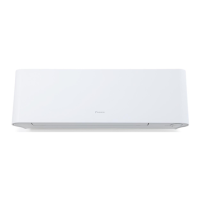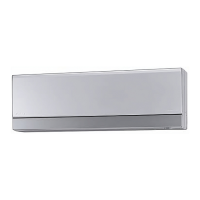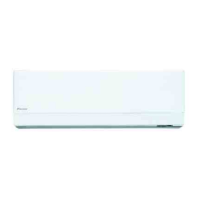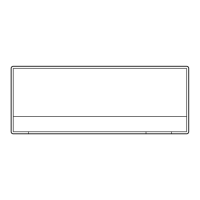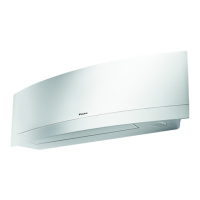Do you have a question about the Daikin FTXG50JV1BA and is the answer not in the manual?
Covers multilingual warnings, sound pressure levels, and intended use for user safety.
Highlights the Intelligent Eye sensor for occupancy detection and the Weekly Timer for scheduling.
Describes the Comfort Airflow for directed air and Outdoor Unit Quiet for noise reduction.
Details general warnings about personal injury, property damage, fire, and explosion risks.
Covers safe installation, electrical precautions, moisture handling, and environmental considerations.
Identifies parts of the indoor unit, including the panel, outlets, display, and indicators.
Identifies outdoor unit parts like air inlets, outlets, sensors, and refrigerant piping.
Details the remote controller's transmitter, receiver, display, and button layout.
Explains buttons for selecting operation mode, quiet operation, and swing airflow.
Covers buttons for setting timers, Intelligent Eye, and Econo modes.
Guides on installing batteries in the remote and fixing the wall holder.
Instructions for turning on the breaker and setting the unit's internal clock.
Details on how to start and stop various operation modes like AUTO, COOL, HEAT, DRY, and FAN.
Covers temperature setting, energy saving tips, and recommended operating conditions.
Instructions on adjusting vertical and horizontal airflow direction for optimal comfort.
Guides on setting fan speed and managing flap angles for desired airflow.
Explains the Comfort Airflow mode for directing air upwards or downwards.
Details how the Intelligent Eye sensor saves energy by detecting room occupancy.
Describes the Powerful operation for maximizing cooling or heating capacity.
Explains how to reduce outdoor unit noise for nighttime or quiet environments.
Details the Econo mode for limiting maximum power consumption.
Instructions for setting the air conditioner to turn off automatically.
Instructions for setting the air conditioner to turn on automatically.
Introduction to the Weekly Timer for setting up to 4 programs per day.
Guides on how to set, confirm, and adjust weekly timer reservations.
Explains how to copy timer settings to other days of the week.
Describes how to check existing weekly timer reservation details.
Instructions for removing individual or all weekly timer reservations.
Covers selecting operation modes and understanding priority settings in multi-unit systems.
Explains mode lock, priority room settings, and priority during Powerful/Quiet operations.
Step-by-step guide for cleaning the unit's front panel and air filters.
Instructions for maintaining the photocatalytic air-purifying filters.
Guidance on checking unit condition and preparing for long periods of non-use.
Addresses common indoor unit problems like flap movement, airflow, and unusual sounds.
Covers issues related to the outdoor unit emitting water/steam and remote controller malfunctions.
Lists general checks before calling service and safety measures during troubleshooting.
Details specific faults like timer errors, odor, sudden stops, and front panel issues.
Identifies critical faults requiring immediate service and provides disposal guidelines.
Explains how to use error codes displayed on the remote controller for diagnosis.
Interprets LED status lights on the outdoor unit's PCB for fault diagnosis.
Covers multilingual warnings, sound pressure levels, and intended use for user safety.
Highlights the Intelligent Eye sensor for occupancy detection and the Weekly Timer for scheduling.
Describes the Comfort Airflow for directed air and Outdoor Unit Quiet for noise reduction.
Details general warnings about personal injury, property damage, fire, and explosion risks.
Covers safe installation, electrical precautions, moisture handling, and environmental considerations.
Identifies parts of the indoor unit, including the panel, outlets, display, and indicators.
Identifies outdoor unit parts like air inlets, outlets, sensors, and refrigerant piping.
Details the remote controller's transmitter, receiver, display, and button layout.
Explains buttons for selecting operation mode, quiet operation, and swing airflow.
Covers buttons for setting timers, Intelligent Eye, and Econo modes.
Guides on installing batteries in the remote and fixing the wall holder.
Instructions for turning on the breaker and setting the unit's internal clock.
Details on how to start and stop various operation modes like AUTO, COOL, HEAT, DRY, and FAN.
Covers temperature setting, energy saving tips, and recommended operating conditions.
Instructions on adjusting vertical and horizontal airflow direction for optimal comfort.
Guides on setting fan speed and managing flap angles for desired airflow.
Explains the Comfort Airflow mode for directing air upwards or downwards.
Details how the Intelligent Eye sensor saves energy by detecting room occupancy.
Describes the Powerful operation for maximizing cooling or heating capacity.
Explains how to reduce outdoor unit noise for nighttime or quiet environments.
Details the Econo mode for limiting maximum power consumption.
Instructions for setting the air conditioner to turn off automatically.
Instructions for setting the air conditioner to turn on automatically.
Introduction to the Weekly Timer for setting up to 4 programs per day.
Guides on how to set, confirm, and adjust weekly timer reservations.
Explains how to copy timer settings to other days of the week.
Describes how to check existing weekly timer reservation details.
Instructions for removing individual or all weekly timer reservations.
Covers selecting operation modes and understanding priority settings in multi-unit systems.
Explains mode lock, priority room settings, and priority during Powerful/Quiet operations.
Step-by-step guide for cleaning the unit's front panel and air filters.
Instructions for maintaining the photocatalytic air-purifying filters.
Guidance on checking unit condition and preparing for long periods of non-use.
Addresses common indoor unit problems like flap movement, airflow, and unusual sounds.
Covers issues related to the outdoor unit emitting water/steam and remote controller malfunctions.
Lists general checks before calling service and safety measures during troubleshooting.
Details specific faults like timer errors, odor, sudden stops, and front panel issues.
Identifies critical faults requiring immediate service and provides disposal guidelines.
Explains how to use error codes displayed on the remote controller for diagnosis.
Interprets LED status lights on the outdoor unit's PCB for fault diagnosis.
| Cooling Capacity | 5.0 kW |
|---|---|
| Seasonal Energy Efficiency Ratio (SEER) | 6.10 |
| Coefficient of Performance (COP) | 4.00 |
| Refrigerant | R32 |
| Outdoor Unit Noise Level | 50 dB(A) |
| Type | Wall Mounted |
| Power Supply | 230V/50Hz |




